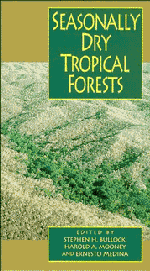Book contents
- Frontmatter
- Contents
- List of contributors
- Acknowledgements
- 1 Introduction
- 2 Dry forests of Central America and the Caribbean
- 3 Overview of the Brazilian caatinga
- 4 Savannas, woodlands and dry forests in Africa
- 5 Dry forest ecosystems of Thailand
- 6 The Cenozoic record of tropical dry forest in northern Latin America and the southern United States
- 7 Diversity and floristic composition of neotropical dry forests
- 8 Vertebrate diversity, ecology and conservation in neotropical dry forests
- 9 Diversity of life forms of higher plants in neotropical dry forests
- 10 Drought responses of neotropical dry forest trees
- 11 Plant reproduction in neotropical dry forests
- 12 Plant–herbivore interactions in Mesoamerican tropical dry forests
- 13 Biomass distribution and primary productivity of tropical dry forests
- 14 Nutrient cycling in tropical deciduous forests
- 15 Biology of the belowground system of tropical dry forests
- 16 Nitrogen trace gas emissions in a tropical dry forest ecosystem
- 17 Conversion of tropical dry forest to pasture and agriculture
- 18 Ethnobotany of the Mexican tropical dry forests
- Index
13 - Biomass distribution and primary productivity of tropical dry forests
Published online by Cambridge University Press: 07 September 2010
- Frontmatter
- Contents
- List of contributors
- Acknowledgements
- 1 Introduction
- 2 Dry forests of Central America and the Caribbean
- 3 Overview of the Brazilian caatinga
- 4 Savannas, woodlands and dry forests in Africa
- 5 Dry forest ecosystems of Thailand
- 6 The Cenozoic record of tropical dry forest in northern Latin America and the southern United States
- 7 Diversity and floristic composition of neotropical dry forests
- 8 Vertebrate diversity, ecology and conservation in neotropical dry forests
- 9 Diversity of life forms of higher plants in neotropical dry forests
- 10 Drought responses of neotropical dry forest trees
- 11 Plant reproduction in neotropical dry forests
- 12 Plant–herbivore interactions in Mesoamerican tropical dry forests
- 13 Biomass distribution and primary productivity of tropical dry forests
- 14 Nutrient cycling in tropical deciduous forests
- 15 Biology of the belowground system of tropical dry forests
- 16 Nitrogen trace gas emissions in a tropical dry forest ecosystem
- 17 Conversion of tropical dry forest to pasture and agriculture
- 18 Ethnobotany of the Mexican tropical dry forests
- Index
Summary
Introduction
A large amount of work has been published on various aspects of the functioning at the ecosystem level in forests throughout the world. However, information for tropical dry forests is sparse. In comprehensive reviews of forest productivity studies (Bray & Gorham, 1964; Art & Marks, 1971; Murphy, 1975; Jordan & Murphy, 1978; Brown & Lugo, 1982; Proctor, 1984; Vitousek, 1984; Murphy & Lugo, 1986a; Vogt, Grier & Vogt, 1986), there are no more than ten references regarding studies on primary productivity of tropical dry forests. Subsequently a few more studies have been published, particularly from Brazil, México, Puerto Rico and India (Table 13.1).
This review of biomass distribution and primary productivity of tropical dry forests emphasizes the aboveground portion of the vegetation. There is no consensus on a precise definition of dry forest. Following Murphy & Lugo (1986a), my review includes tree-dominated sites in tropical regions in which at least the dominant trees are drought deciduous. These sites include those with strongly seasonal climate, that is, including a well-defined dry season. Mean annual rainfall is usually below 1500 mm and annual potential evapotranspiration:precipitation ratio is normally greater than one.
After a review of forest phytomass, I survey the process of litterfall and of litter decomposition, treating methodologies reviewed by Proctor (1983) and Wieder & Lang (1982). The significance of litterfall and litter decomposition in nutrient cycling in tropical deciduous forests is presented in detail by Jaramillo & Sanford (Chapter 14). Finally, I examine the few attempts that have been made to estimate net primary productivity (NPP).
- Type
- Chapter
- Information
- Seasonally Dry Tropical Forests , pp. 326 - 345Publisher: Cambridge University PressPrint publication year: 1995
- 40
- Cited by



